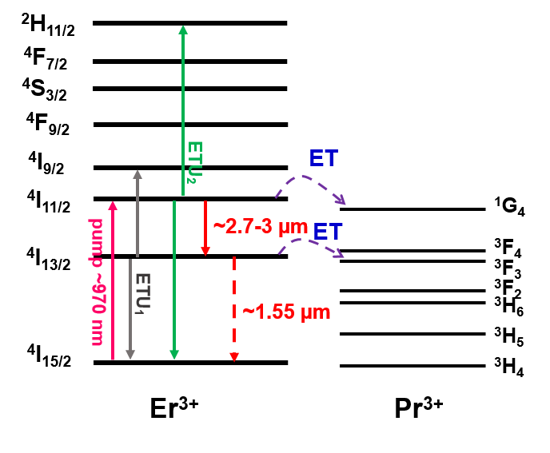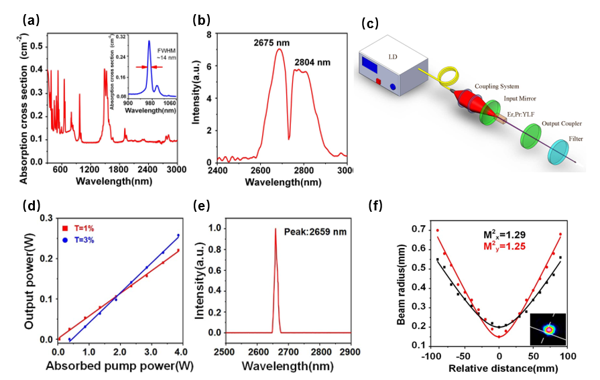Er,Pr:YLF, a novel mid-infrared laser crystal at 2.7 µm
The research group led by Prof. Jingliang He, Baitao Zhang from Shandong University co-operated with the group of Prof. Haiping Xia from Ningbo University, have designed and fabricated high-quality Er,Pr:YLF crystal and obtained high-power and high-efficiency 2.7 µm mid-infrared (MIR) radiation. This research result was published in Chinese Optics Letters, Vol. 19, No. 8 (Haiping Xia, Jingliang He, and Baitao Zhang et al, Spectroscopic and laser properties of Er3+, Pr3+ co-doped LiYF4 crystal).
Coherent laser source emitting mid-infrared (MIR) radiation in 3 µm wavelength band has several unique features including: (ⅰ) located at the well-known atmospheric transparency window; (ⅱ) corresponding to the strong rovibrational absorption lines of various gas molecules; (ⅲ) overlapping the strong absorption peak of water. Based on the above merits, it has recently attracted tremendous attention owing to the potential applications in remote sensing, laser surgery, gas monitoring and detection, precision spectroscopy measurement, material processing and countermeasure, etc. Up to now, the most advanced MIR solid-state laser technologies that used for 3 µm laser generation including but not limited to the rare-earth doped crystalline and fiber lasers, the semiconductor laser diodes (LDs), the quantum cascade lasers (QCLs), and nonlinear optical frequency conversion (optical difference frequency generation (DFG), optical parametric sources (OPSs, including optical parametric oscillators (OPOs), optical parametric generators (OPGs)), etc.), and so on. Over the past two decades, benefiting from the great progress in material science and technology, a lot of MIR laser gain materials, especially rare-earth doped crystalline and fiber materials with excellent optical, thermal and mechanical properties have been developed. Thus far, direct laser emissions in 3 µm spectra region have become the main technique for 3 µm laser generation, which have the significant advantages of low cost, high efficiency, simple structure, and low loss.
Besides the well-known laser transition of 4I13/2→4I15/2 emitting wavelength around 1.55 µm, Er3+ ion can also provide 2.7-3 µm MIR emission with 4I11/2→4I13/2 transition. The simplified energy-level diagram of Er3+-doped gain medium is shown in Fig. 1. Easy growing and the pumping wavelength around ~970 nm (commercial LD operation wavelength) are the two fundamental merits that make Er3+-doped crystals to be much more extensively studied for 2.7-3 µm laser generation compared to that of Ho3+- and Dy3+- doped crystals. However, for Er3+:4I11/2→4I13/2 transition, there is a so-called self-terminated effect leading to population bottleneck issue caused by the life time of upper laser level (4I11/2) much shorter than that of lower level (4I13/2), which is the main obstacle that prevents the development of Er3+-doped 2.7-3 µm crystalline lasers.

Fig.1 The simplified energy-level diagram of Er3+-doped gain medium
Up to now, several approaches have been developed to solve this detrimental feature. One is increasing the doping concentration of Er3+ ion to generate "quenching effect", which could decrease the lifetime of Er3+:4I13/2 so as to relieve the self-terminating behavior. Energy-transfer up-conversion (ETU) process between Er3+ and Er3+ ions in highly doped crystals can also effectively depopulate Er3+:4I13/2 to solve the population bottleneck issue. But it should be noticed that it is a double-edged sword because of the severe thermal effects and the lifetime reducing of the upper laser level Er3+:4I11/2. Another approach is co-doped with deactivated ions (typically Pr3+) with efficient depopulation of Er3+:4I13/2 for establishing and sustaining population inversion, as shown in Fig. 1. Besides, the host material is another essential factor for Er3+:4I11/2→4I13/2 transition, which should have low photon energy, high radiative emission rate, and low absorption in 2.7 µm band.
The research group led by Prof. Jingliang He, Baitao Zhang from Shandong University co-operated with the group of Prof. Haiping Xia from Ningbo University, have designed and fabricated high-quality Er,Pr:YLF crystal and studied its spectroscopy and laser properties thoroughly. The Pr3+ co-doping was proved to effectively enhance the Er3+: 4I11/2→4I13/2 mid-infrared (MIR) transition at the 2.7 μm with 74.1% of energy transfer efficiency from Er3+: 4I13/2 to Pr3+: 3F4. By using Judd-Ofelt (J-O) theory, the stimulated emission cross section was calculated to be 1.834×10-20 cm2 at 2685 nm and 1.359×10-20 cm2 at 2804.6 nm. Moreover, diode-end-pumped Er,Pr:YLF laser operating at 2659 nm was realized with the maximum output power of 258 mW and a slope efficiency of 7.4%. The corresponding beam quality factor Mx2=1.29 and My2=1.25. The results are shown in Fig.2. The higher-efficiency, higher-power Er,Pr:YLF CW lasers are expected by optimizing the concentration of Er3+ and Pr3+ ions.

Fig. 2 (a)Absorption cross section of Er,Pr:YLF;(b)Fluorescence spectrum of Er,Pr:YLF;(c)Schematic setup of LD end-pumped Er,Pr:YLF laser;(d)Laser output power versus input power with different transmissions;(e)Center emission wavelength of the Er,Pr:YLF laser;(f)Laser beam quality of the Er,Pr:YLF laser. Inset: the far-field laser beam profile.


